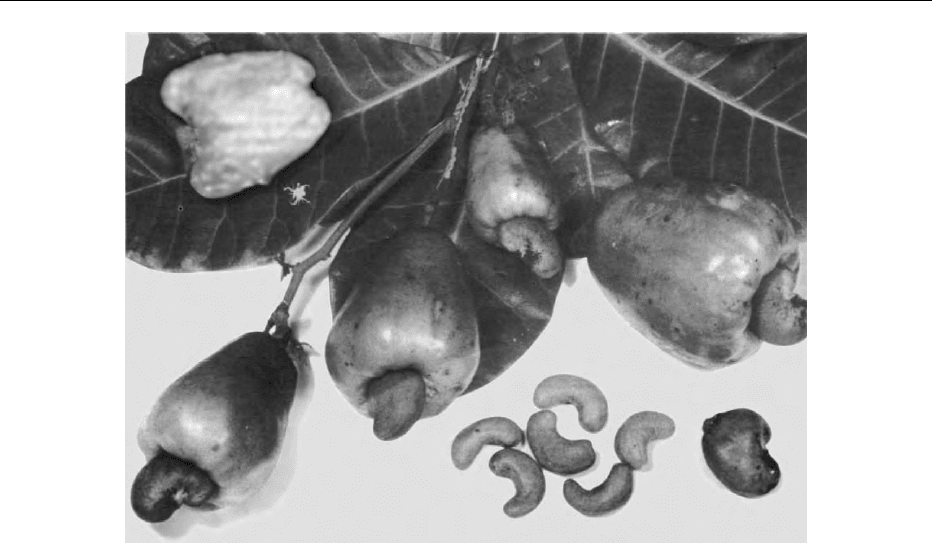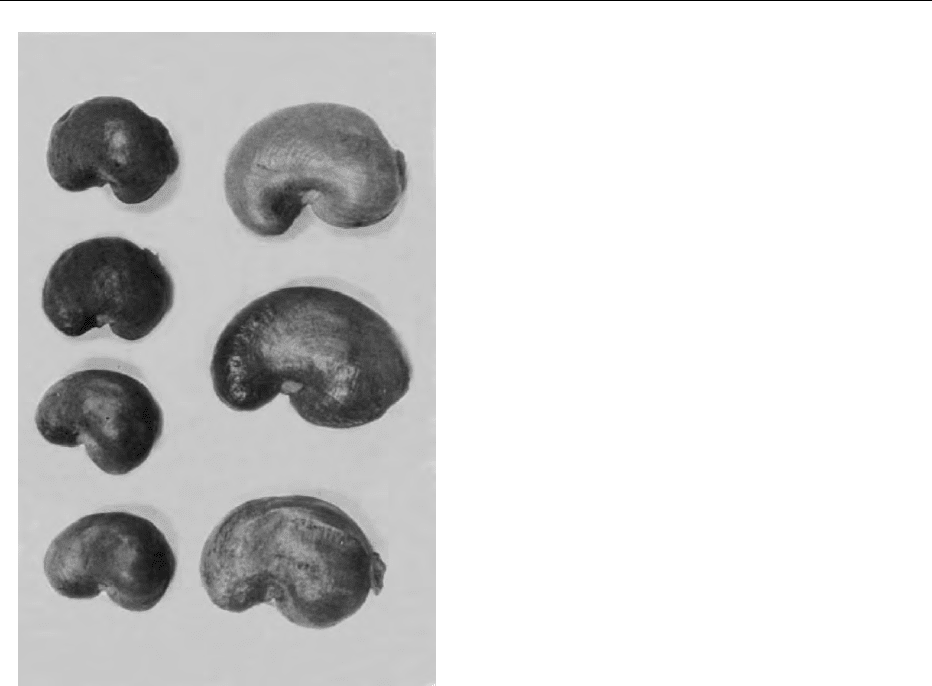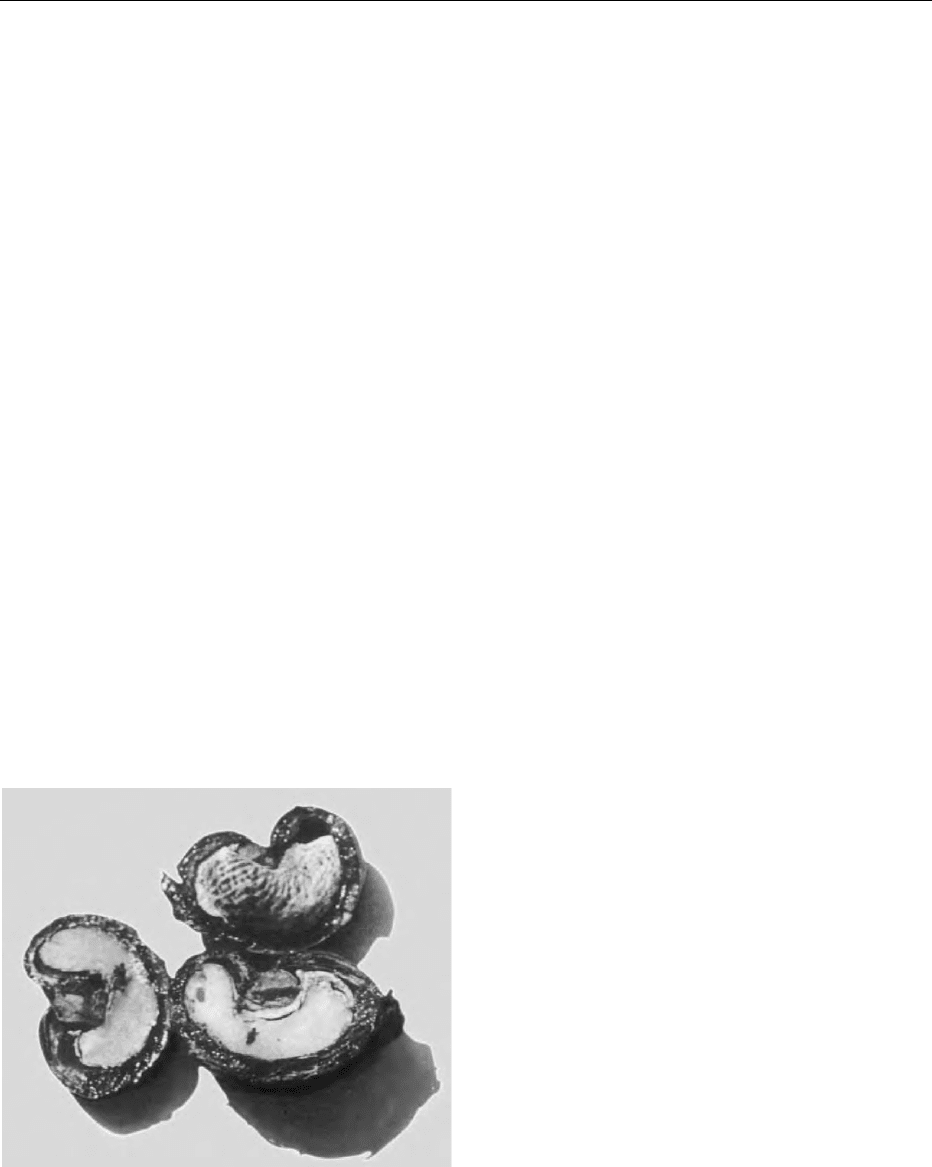Caballero B. (ed.) Encyclopaedia of Food Science, Food Technology and Nutrition. Ten-Volume Set
Подождите немного. Документ загружается.


hydrolysates and solutions of caseinates, TMP
1
and/
or milk protein hydrolysates for intravenous nutrition
in intestinal disorders, veterinary medicine, and dis-
orders involving protein metabolism. Some prepar-
ations of casein have been used for feeding patients
following surgery, as a therapeutic agent in dressing
wounds, in cosmetics, in toothpaste for inhibition of
dental caries, and in hair shampoos. The potential for
producing specific drugs, such as opiates, from casein
has been described, and other extracts from casein
have been claimed as being suitable for treatment of
arthrosis (pain in a joint) and gastric ulcers, for en-
hancement of calcium and iron absorption, and to
augment immunity. Table 12 illustrates some recent
published claims for applications of casein products
in this field.
Health and Nutrition
0029As indicated earlier in this article, a significant pro-
portion of the population in the wealthier and indus-
trialized countries has some concern with regard to
their health and nutrition. Such concern has been seen
in the great proliferation of nutritional supplements
for loss or gain of weight. Other supplements are sold
to provide a certain percentage of the recommended
dietary allowance of various vitamins and minerals,
fiber, protein, etc. Preparations that contain casein
tbl0010 Table 10 Use of casein products in edible films
Examples Caseinproduct used % Use/function of casein product
General
Edible film Lactic acid casein, rennet casein 37.5–59 Strength, moisture and oxygen barrier
Irradiated edible film Sodium or calcium caseinate 33–50 Mechanical strength, flexibility
Ultrasound-treated edible film Sodium caseinate 100 Mechanical strength, moisture barrier
Fruits and vegetables
Coating for apples and celery sticks Calcium caseinate 50
a
Moisture barrier
Edible coating for zucchini Calcium caseinate 15–45
a
Barrier for moisture
Film for fruit and vegetables Sodium caseinate 0–50
a
Moisture barrier
Food containers
Biodegradable food containers Casein 0.1–10 Water resistance
Edible film for foods (coconut,
cereal, peanuts, almonds)
Casein/caseinate 83–86 Barrier for liquids and flavors
Biodegradable flexible packaging film Casein/caseinate 33–50 Barrier to water, gases, and microorganisms
a
Expressed as a percentage (dry basis) of the coating weight.
tbl0011 Table 11 Use of casein products in microencapsulation
Examples Casein product used % Use/function of casein product
Nutrition
Microparticles containing physiologically active
substances
Casein NS Forms ‘shell’ and acts as edible binder
Microencapsulated oil or fat for nutrition and infant
formula
Caseinate NS Matrix formation
Odors and flavors
Film for liver powder Caseinate ‘Major part’ Odor barrier
Film for garlic Caseinate NS Flavor and odor barrier
Film for horseradish paste Casein NS Odor barrier
Film for fruit Caseinate NS Color and flavor barrier
NS, not stated.
tbl0012 Table 12 Pharmaceutical and medical applications of casein products
Examples Casein product used % Use/function of casein product
Coated cytochrome-c drug for intestinal absorption Casein NS Coating
Nitrogen source for patients Casein/caseinate 7–12 (of protein) Nutrition
Preventing agents for hyperlipidemia Casein/caseinate 100 Binds fat or cholesterol
Hard capsules Casein 20–80 Matrix
Ferro-succinyl casein complex Casein [100] Nutrition
NS, not stated.
956 CASEIN AND CASEINATES/Uses in the Food Industry

products are among these supplements and a selection
of these, taken from the published literature, is in-
cluded in Table 13. Figure 7 shows a chocolate-
flavored health drink that contains calcium sodium
caseinate and/or milk protein isolate (consisting of
caseins and whey proteins).
Conclusion
0030 In the majority of the applications described above,
where casein is used to provide a specific functional
or physical effect, it is incorporated in the food in
relatively small quantities, i.e., generally below 10%
by weight of the product. Unlike other dairy
products, such as milk and milk powder, butter and
cheese, it is not consumed as a food per se. However,
when casein is used for nutrition, it may indeed rep-
resent a significant proportion of the total weight of
the food. In pharmaceutical and medical applications,
there are some indications that derivatives of casein
may be important therapeutic agents in the future.
See also: Cakes: Methods of Manufacture; Cheeses:
Processed Cheese; Fats: Fat Replacers; Liqueurs:
Cream Liqueurs; Low-fat Foods: Types and
Manufacture; Low-fat Spreads; Meat: Sausages and
Comminuted Products; Milk: Dietary Importance; Pasta
and Macaroni: Methods of Manufacture; Protein:
Functional Properties; Digestion and Absorption of
Protein and Nitrogen Balance; Satiety and Appetite:The
Role of Satiety in Nutrition; Food, Nutrition, and Appetite;
Yogurt: The Product and its Manufacture
Further Reading
Centre National du Commerce Exte
´
rieur (1970) The
United States Market for Edible Caseins and Caseinates.
Paris: Centre National du Commerce Exte
´
rieur.
Jelen P and Lutz S (1998) Functional milk and dairy prod-
ucts. In: Mazza G (ed.) Functional Foods: Biochemical
and Processing Aspects, pp. 357–380. Lancaster, Penn-
sylvania: Technomic.
Manson W (1980) The use of milk and milk constituents in
pharmaceutical preparations. Factors Affecting the
Yields and Contents of Milk Constituents of Commercial
Importance. International Dairy Federation. Bulletin,
document 125, pp. 60–65. Brussels: International
Dairy Federation.
Meisel H and Schlimme E (1996) Bioactive peptides derived
from milk proteins: ingredients for functional foods? Kie-
ler Milchwirtschaftliche Forschungsberichte 48: 343–357.
Muller LL (1971) Manufacture and uses of caseins and
co-precipitate. Dairy Science Abstracts 33: 659–674.
Mulvihill DM (1992) Production, functional properties and
utilization of milk protein products. In: Fox PF (ed.)
Advanced Dairy Chemistry, vol. 1, pp. 369–404.
London: Elsevier Applied Science.
Schuette HA (1939) Alimentary and medicinal uses of
casein. In: Sutermeister E and Browne FL (eds) Casein
tbl0013 Table 13 Use of casein products in health and nutrition, weight loss, and satiation
Examples Casein product used % Use/functionof casein product
Trace mineral composition Caseinate 90 Complexing agent
Beverage/health drink Caseinate 1–7 Accelerates muscle activity
Magnesium or calcium caseinate Casein [100] Promotes absorption of Mg and Ca
Rice-based infant cereal Casein phosphopeptide 0–2 g/serving Ca and Zn absorption promoter
Satiation
Food composition Casein/caseinate 33–67
a
Satiety
Appetite suppressant Casein/sodium caseinate/calcium caseinate 2.5–4.8 Prevents overeating
a
Dry basis.
fig0007 Figure 7 (see color plate 18) Chocolate drink, representing
products for health and nutrition that can be fortified using milk
protein isolates and calcium, potassium, or magnesium case-
inates. Courtesy of NZMP (North America) Inc.
CASEIN AND CASEINATES/Uses in the Food Industry 957

and its Industrial Applications, 2nd edn, pp. 366–390.
New York: Reinhold.
Southward CR (1989) Uses of casein and caseinates. In
Fox PF (ed.) Developments in Dairy Chemistry, vol. 4,
pp. 173–244. London: Elsevier Applied Science.
Southward CR (1994) Utilisation of milk components:
casein. In: Robinson RK (ed.) Modern Dairy Technol-
ogy, 2nd edn, vol. 1, Advances in Milk Processing, pp.
375–432. London: Chapman and Hall.
Southward CR and Walker NJ (1982) Casein, caseinates
and milk protein co-precipitates. In: Wolff IA (ed.) CRC
Handbook of Processing and Utilization in Agriculture,
vol. I, pp. 445–552. Boca Raton, Florida: CRC Press.
Webb BH (1970) Miscellaneous products. In: Webb BH and
Whittier EO (eds) Byproducts from Milk, pp. 285–330.
Westport, Connecticut: AVI.
CASHEW NUTS AND CASHEW APPLES
J F Morton
{
, University of Miami, Coral Gables,
FL, USA
This article is reproduced from Encyclopaedia of Food Science,
Food Technology and Nutrition, Copyright 1993, Academic Press.
Introduction
0001 The cashew is one of the two costliest nuts marketed
in quantity worldwide. Formerly second to the maca-
damia nut in retail value, it is now more expensive
because of short supply. Few people in the northern
hemisphere question why the cashew nut is never sold
in the shell as peanuts, pecans, walnuts, and almonds
often are. There is a good reason for this. The cashew,
by nature, is much more complex than other nuts and
a technical explanation of its processing is required.
Description
0002 The cashew tree, Anacardium occidentale, of the
family Anacardiaceae, is short-trunked, up to 13 m
high and normally with a very broad crown, although
it is often stunted and bushy on coasts. There is an
enormous, very old, wild cashew tree in Natal, Brazil,
that covers 0.75 ha and is a great tourist attraction. Its
leathery, evergreen leaves are clustered at the branch
tips. The small, yellow-and-red flowers are borne in
open sprays. The true fruit of the tree is the kidney-
shaped, hard-shelled nut that is at first green, later
turning an ashy brown; it grows to 3 cm or more in
length and develops at the tip of a fleshy stalk. As the
‘nut’ matures, the stalk inflates to form a showy, pear-
shaped, smooth-skinned, succulent, juicy pseudofruit
(false fruit), which is bright-red, orange, yellow, or
two-tone and is usually viewed, and utilized, as a fruit
(Figure 1). The weight of the expanded pseudofruit
causes the nut to fall to the ground at its peak of
maturity. A caustic oil in the honeycomblike cells
within the double-layered shell of the ‘nut’ protects
it from being destroyed by foragers that feed on the
‘apple.’ However, the oil seriously complicates the
processing of the ‘nut’ and extraction of its kernel
for food use.
Origin and Distribution
0003The cashew tree is native from southern Mexico to
Peru, Brazil, and the West Indies. Wild stands extend
along the coast of Brazil from Para
´
to Rio de Janeiro,
and the nut and apple have always been of import-
ance to the indigenous people. The cashew was one of
the first tropical American fruit trees to be introduced
by early Portuguese and Spanish voyagers into the
tropics of the Old World. In the sixteenth century
the Portuguese planted it, especially on the west
coast of India and the east coast of Mozambique, in
order to halt soil erosion and, in time, it formed
extensive forests.
0004The tree soon became commonly cultivated and
naturalized at low altitudes in East, Central, and
West Africa, South-east Asia, Sri Lanka, Malaysia,
the Philippines, Mauritius, and the Seychelles. In add-
ition, it has been planted around villages in most of
the Pacific Islands, including Hawaii, and is occasion-
ally grown in dooryards in southern Florida.
0005The name ‘cashew’ is derived from the Brazilian
acaju, usually abbreviated to caju. In the Orinoco
region, the tree is known as pauji. In all the Spanish-
speaking countries of Latin America and the Carib-
bean area, the common name is maran
˜
on, except in
Venezuela where it is called merey. In French it is
cajou or acajou.
Climate and Soil
0006The tree requires a tropical or subtropical climate. It is
highly sensitive to frost when young, but later is able to
withstand brief cold spells. It is well adapted to sandy
soil, intolerant of heavy clay, and is drought- and
{
Deceased.
958 CASHEW NUTS AND CASHEW APPLES

salt-tolerant, succeeding on land too poor for most
other crops. It thrives from sea level to an altitude
of 1000 m.
Commercial Development
0007 India pioneered the domestication and commercial-
ization of the cashew and, for a long time, augmented
supply by importing raw nuts from Mozambique.
The 1950s saw large-scale planting of cashew trees
in Africa, India, and Brazil. In north-eastern Brazil
there was first a private plantation of about 1500 ha.
Then, in 1957, a programme was begun to plant a
million trees in the state of Ceara
´
, the government
supplying the seeds and a bonus for each tree set out in
plots of 100 or more. From 1957 to 1972, a company
in Pacajus set out 2000 ha. Another surge of govern-
ment-stimulated plantings totalled nearly 136 000 ha
by 1972, mostly in Ceara
´
. Later, 18 000 ha were de-
veloped in Rio Grande do Norte. By 1986, more than
40 000 ha of cashew had been added in reforestation
programs in Ceara
´
, Piaui, Rio Grande do Norte, and
Bahia.
0008 There have been sporadic attempts to develop
cashew industries in Venezuela, Colombia, Peru, Gua-
temala, Belize, and Jamaica. Some have been moder-
ately successful. The primary problem is that cashew
trees are still mainly grown from seed and there
is great variation in yield, and great variability in
the form and size of the nuts from seedling trees
(Figure 2). The nuts may range from 3 to 32 g in
weight and the apples (mostly orange or yellow)
from 15 to 650 g. Trees bearing small nuts tend to
produce heavily, while trees with large nuts and apples
are less productive and may bear in alternate years.
0009Much research in Mozambique and India has been
devoted to techniques of vegetative propagation (by
cuttings, grafting, budding, or air layering) to achieve
uniformity, but it is still not widely practiced, mainly
because of the costs involved. India has accomplished
much in rejuvenation of old groves by top-working
beheaded, unproductive trees. Side-veneer grafting
has been recommended in Venezuela. In Trinidad
and India air-layered trees have poor form and tend
to blow over in the wind. Once a method of propaga-
tion has been adopted, there must be a search for the
best types to be grown. An experimental planting of
grafted trees was initiated in Ceara
´
but did not pros-
per because of a prolonged drought. In 1980, a
selected clone of a ‘dwarf’ cashew was grafted on to
Anacardium microcarpum and the 40 trees set out
fruited early and were highly drought-resistant. This
trial encouraged experiments with other rootstocks
and selection of high-quality clones, but low yields
fig0001 Figure 1 The cashew nut, shaped like a boxing glove, develops at the tip of a fleshy, juicy, fruitlike stalk (peduncle), called cashew
apple, which enlarges as the nut matures, becomes red, orange, yellow, or two-tone, and is eaten raw or preserved. Reproduced from
Cashew Nuts and Cashew Apples, Encyclopaedia of Food Science, Food Technology and Nutrition, Macrae R, Robinson RK and Sadler MJ
(eds), 1993, Academic Press.
CASHEW NUTS AND CASHEW APPLES 959

have caused such work to languish. There are still no
commercial orchards of selected, vegetatively propa-
gated trees.
Varieties
0010 Generally, named varieties have been distinguished
merely by color and size of the apple, such as the
Vermelho (yellow) and Amarello Gigante (large
yellow) of Brazil, and the Maran
˜
on Amarillo (yellow)
and Maran
˜
on Rosado (red) of Colombia. Natural
hybrids in Colombia have been named La Gigante
(huge) del Rio Magdelena, La Larga (long) de Nazar-
eth, and La Pequen
˜
a (small) del Meta. Usually the nut
and apple are larger in the yellow forms than in the
red, and the apple is less astringent. One name per-
taining not to the apple but to the nut is the Jumbo
grown by the late Edward B Smith, Crescent Estate,
Trinidad, who has supplied air layers to people from
South America wishing to establish this large-seeded
type in their countries.
0011In evaluating cashew trees, preference should be
given to a cashew tree of slender, compact form be-
cause the cashew needs light to flower and fruit and
bears only on its outer circumference. The interior of
a broad-spreading tree is devoid of foliage and fruit.
Likewise, if cashew trees are planted too close to-
gether, the branches that overlap or shade each
other will be nonbearing and may die back. From an
experimental plantation of compact trees, the grower
should select those that produce a high yield of large
nuts and multiply them vegetatively, rather than in-
creasing labor costs by simply planting more and
more seedling trees with yields varying from 5 to
100 kg per tree. There is variation also in the color
of the young leaves of cashew trees. On some, the new
shoots at the branch tips are purplish-red, while on
others they are more or less yellow. The yellow leaves
are heavily attacked by leaf-eating insects while the
red, being richer in phenolic compounds, are natur-
ally insect-resistant.
Diseases and Pests
0012In humid atmospheres and in seasons of excessive
rainfall, cashew trees are subject to attack by the
fungus Colletotrichum gloeosporioides, which causes
anthracnose, a disease affecting the foliage, especially
young shoots, the twigs, flowers, the apple, and the
developing nut. A parasitic fungus, Oidium anarcar-
dii, appears on the leaves, shoots, and flowers when
there are periods of alternating sun and rain. They
become coated with a powdery white substance and
this is followed by blackening, shrivelling, and
shedding. The nut may be ruined by the fungus,
Nematospora spp., which invades it through minute
perforations caused by sucking insects. A large wasp
sucks the juice from immature apples, causing them to
shrivel and blacken while the nut is still green. Yellow,
red-banded thrips (Selenothrips rubrocinctus Giard)
often infest the foliage. Cashew apples are commonly
eaten by birds, bats, monkeys, and squirrels.
Harvesting and Drying
0013Harvesting of cashew nuts is extremely labor-
intensive. The entire crop does not ripen at one
time, and harvesting may extend over a period of
40–75 days. Ideally the nuts should be allowed to
fall (with the apple attached) when perfectly mature.
Some people unwisely shake the branches to bring
them down or knock them off with a pole. This
results in slightly immature nuts of high moisture
content being mixed with partly dried mature nuts
fig0002 Figure 2 Cashew nuts range from 2.5 to 5 cm in length and this
variability, together with the odd shape, contributes to the diffi-
culties of opening them mechanically. They are never sold in
the shell. Reproduced from Cashew Nuts and Cashew Apples,
Encyclopaedia of Food Science, Food Technology and Nutrition,
Macrae R, Robinson RK and Sadler MJ (eds), 1993, Academic
Press.
960 CASHEW NUTS AND CASHEW APPLES

and makes it impossible to assure uniform drying,
thereby adversely affecting all subsequent steps in
processing. In Brazil, cashews are plucked from
the tree only if perfect apples are desired for dessert
use. If allowed to fall, the apple will remain in
good condition on the ground for 2–3 days. If it is
not to be utilized, it is twisted off and left on the
ground for cattle or pigs to consume. If it is wanted
for preserving, it is salvaged and transported to a
packing plant. The nuts are conveyed separately to
be spread out in the sun and dried, with constant
raking, and then stored if they are not to be immedi-
ately shelled. Thoroughly dried nuts can be stored for
1 or 2 years.
Processing
0014 In Latin America and the West Indies there have been
crude precracking practices such as boiling the nuts in
steel barrels, simply drying them in the sun for 2 or 3
days, or sweating them in cement bins for several
months. There was much loss because many nuts
were found to be infested with insects or fungi on
opening. In some cases the nuts were cut open by
machete wielders with their hands wrapped in layers
of plastic. The half-kernels were then picked out and
sent to local clubs or bars, but these nuts were too
contaminated with the cashew nut shell liquid
(CNSL) to be fit for consumption (Figure 3).
0015Sanitary processing of cashews in the past was best
performed in India by roasting the nuts in shallow
pans over open fires to expel the caustic CNSL, some
of which was caught in jars below for various local
uses. Then they rubbed the nuts with sand or ashes
before handshelling, at which the Indian female
workers were especially adept. But the fumes from
the roasting were extremely irritating to eyes, nose,
throat, and skin, and the shellers frequently had to dip
their hands in lime, ash, or linseed or castor oil to
minimize skin inflammation. A merciful improve-
ment was a change to roasting in rotating cylinders
over furnaces with chimneys to carry off the toxic
fumes. The next advance, brought about by Mortimer
Harvey, of New Jersey, who had investigated the
chemistry and potential industrial uses of the shell
oil, was a method of heating the nuts in baths of the
oil kept at 188–194
C. This method resulted in
greater recovery of higher-quality oil.
0016Semimechanized shelling was initiated in Brazil in
1946. Dried raw nuts were first steamed to moisten
the shells and then fed into a device, operated by hand
and footpedal simultaneously, which cut the shell into
two halves, leaving the kernel whole or cut in half.
Facing the cutter, a seated operator pries the kernel
loose from the cut shells if it adheres. This system is
still used in Ceara
´
for shelling very large nuts.
0017When East African countries achieved independ-
ence from colonial governments, they wanted to
cease exporting their raw cashews to India in order
to gain more revenue by processing the nuts them-
selves. A simple, raw-cashew opening-machine
was invented by a mining engineer in Tanzania in
1960. The operator protected his hands with barrier
cream. There followed the development of complete
factory installations of cashew-shelling equipment
in Italy, France, and Germany. Mozambique
obtained its first full-scale factory in 1964 and 2
years later set a world record in cashew production;
most of the crop went to India for shelling, while the
rest (26 000 t) of the locally shelled kernels was
exported to the USA, West Germany, and South
Africa.
0018The various systems of cracking by pressure, cen-
trifugal cracking, and cutting or sawing were evalu-
ated by the Tropical Products Institute of London
(now the Natural Products Institute), and the Sturte-
vants Engineering Company began producing and
exporting the centrifugal shelling equipment in 1970.
This system is now used by Brazil Oiticica, and modi-
fied versions are used in north-eastern Brazil. An
Italian factory installation of a series of machines,
designed by the Instituto Agronomico per l’Oltre-
mare, involves 15 steps. The dried nuts are cleaned,
roughly sorted according to size, wetted for several
fig0003 Figure 3 Cut open with a machete, these cashew nut halves
show the caustic, glistening cashew nut shell liquid (CNSL) which
is usually expelled by roasting before the nuts are opened
and the kernel is extracted, peeled, and reroasted before con-
sumption. Reproduced from Cashew Nuts and Cashew Apples,
Encyclopaedia of Food Science, Food Technology and Nutrition,
Macrae R, Robinson RK and Sadler MJ (eds), 1993, Academic
Press.
CASHEW NUTS AND CASHEW APPLES 961

days to the desired moisture content, roasted in CNSL,
centrifuged to eliminate any oil residue, cooled, and
mechanically calibrated to separate eight sizes. The
nuts are then machine-cut, and the shell separated
from the kernel and removed by pneumatic tubes
for use as a fuel. The kernels are dried for 48 h in
the sun or in ovens until the testa wrinkles and is
removed mechanically. The kernels are rehumidified
to resist breaking; they are then sorted into wholes
and pieces. Lastly, kernels that still have clinging testa
must be hand-peeled. Japanese processors freeze the
nuts instead of roasting them before shelling.
0019 However, none of these or other factory systems
have given ideal results, mainly because of the vari-
ability of the raw material. There is a great need for a
portable, simple cashew sheller that can take dehy-
drated, raw nuts of any size, splitting them without
contamination of the kernel. The shells would be sent
to facilities for total extraction of the oil for industrial
purposes, and the split kernels of Jumbo cashews
should not be inferior to whole kernels from smaller
nuts. Such shelling has been achieved experimentally
with explosive decompression, but further refinement
of the method is needed.
0020 The latest development in India is a cashew kernel
drier, electronically controlled, with timer and alarm
to avoid scorching, and adjustable dampers for air
inflow; the drier turns out higher-quality kernels in
60–90 min.
Economic Status
0021 In the past, the cashew ranked as India’s second dollar
earner. After mechanization, India found that the
total crop of its cashew plantations could not keep
its big factories busy as the productivity of the trees
declined after they reached 35 years of age. In Kerala,
the leading growing area, cashew orchards have been
cut down and replaced by more profitable rubber
plantations. From 1980 to 1987, the World Bank
assisted India in a cashew development project to
improve old plantations and establish new ones. In
1990, adverse weather conditions in India and other
major cashew areas seriously affected the supply of
cashews for export. Indian production was reduced
by 20–25%, causing a sharp increase in prices. Never-
theless, the demand for cashew kernels has increased,
especially with the opening of markets in eastern
Europe. In 1989, world export of cashew kernels
from India, Brazil, Mozambique, Kenya, Tanzania,
and other areas amounted to 90 000 t. If horticultural
improvement could be brought up to the level of
cashew engineering, this figure could be doubled or
tripled, and cashews would be less expensive and
more widely enjoyed.
Inspection, Grading, and Packing
0022Before export, cashew kernels go through rigid in-
spection systems, are classified according to grade –
wholes, butts, splits, large and small pieces and baby
bits, also white, scorched, and dessert – and are care-
fully vacuum-packed in 11.3-kg capacity metal con-
tainers, two to a crate. They are then held in cold
storage at temperatures below 9
C. For retail sale,
cashew kernels are usually reroasted in olive, peanut,
or other oil, an adhesive and salt are applied and the
kernels are packed in glass jars or cans. In recent
years, many have been dry-roasted without salt.
High grades have a minimum of split or broken
kernels. Lower grades are mainly utilized by the
bakery or confectionery industries. They are familiar
ingredients in cookies, chocolate bars, and other
products, and are made into cashew butter.
Cashew Apple
0023Because of the difficulty of cracking cashew nuts,
many Latin Americans have habitually discarded the
nut and consumed the cashew apple or, in Spanish,
manzana del maran
˜
on, large heaps of which are seen
on native markets at the height of the season. As it
is fibrous, the apple is massaged and the juice is
squeezed into the mouth as a thirst-quencher, espe-
cially out in the countryside. Inferior types that are
still astringent when ripe are eaten with salt so that
they will not irritate the throat. In the kitchen, cashew
apples may be sliced and stewed or used to make
juice, fruit soup, jam, jelly, paste, or chutney. The
best cashew apples are preserved whole in syrup in
glass jars. The less perfect are candied – cooked thor-
oughly in heavy syrup until well wrinkled, and then
dried and sometimes rolled in granulated sugar. This
is an excellent product resembling candied figs but
it is, of course, seedless.
0024In India, the Central Food Technological Research
Institute at Mysore has found that the astringency
and acridity of cashew apple juice, due to 35% tannin
content and 3% of an oily substance, can be elimin-
ated by pressure steaming for 5–15 min and thorough
washing. Then the juice is mechanically extracted. In
the Philippines, the Bureau of Plant Industry, Manila,
designed a cashew-apple-crushing machine for this
purpose. To free the juice of some other undesirable
elements, casein, gelatin, pectin, or lime juice may be
added before straining or centrifuging. After the add-
ition of sugar and citric acid to arrive at 15
Brix and
4% acidity, the juice is boiled for 1 min and then
bottled or canned, alone or with other fruit juices.
0025In Brazil, it is estimated that less than 10% of the
total cashew apple crop is processed, though the juice
962 CASHEW NUTS AND CASHEW APPLES

is locally popular and, with suspended pulp or clear,
it is pasteurized, preservatives are added, and it is
bottled and exported. The unclarified juice may be
concentrated and bottled as nectar, or made available
as frozen concentrate. Cashew apple juice is also
made into vinegar. In Cuba, Costa Rica, and the
Philippines, and formerly in Brazil, it has been
tbl0001 Table 1 Food value of cashew nuts, oil-roasted and dry-
roasted
Nutrients andunits
a
Mean amount per kg, edible portion
Oil-roasted Dry-roasted
Proximate
Water (g) 39.1 17.0
Food energy (kcal) 5760 5740
(kJ) 24 090 24 020
Protein (N 5.30) (g) 161.5 153.1
Total lipid (fat) (g) 482.1 463.5
Carbohydrate, total (g) 285.2 326.9
Fiber (g) 12.7 7.0
Ash (g) 32.1 39.5
Minerals (mg)
Calcium 410 450
Iron 41.0 60.0
Magnesium 2550 2600
Phosphorus 4260 4900
Potassium 5300 5650
Sodium
b
170 160
Zinc 47.5 56.0
Copper 21.7 22.2
Manganese 8.07
Vitamins
c
Ascorbic acid (mg) 0.0 0.0
Thiamin (mg) 4.24 2.00
Riboflavin (mg) 1.75 2.00
Niacin (mg) 18.00 14.00
Pantothenic acid (mg) 11.90 12.17
Vitamin B
6
(mg) 2.50 2.56
Folacin (mg) 677.0 692.0
Vitamin B
12
(mg) 0 0
Vitamin A (RE) 0 0
(IU) 0 0
Lipids (g)
Fatty acids
Saturated, total 95.26 91.57
4:0
6:0
8:0 1.37 1.32
10:0 1.37 1.32
12:0 8.16 7.84
14:0 3.61 3.47
16:0 45.26 43.51
18:0 30.91 29.72
Monounsaturated, total 284.15 273.17
16:1 3.31 3.18
18:1 278.86 268.08
20:1 1.44 1.39
22:1
Lipids (g)
Fatty acids
Polyunsaturated, total 81.52 78.36
18:2 79.68 76.60
18:3 1.67 1.61
18:4
20:4
20:5
22:5
22:6 0
Cholesterol 0
Phytosterols 1.58
Amino acids (g)
Tryptophan 2.50 2.37
Threonine 6.25 5.92
Isoleucine 7.71 7.31
Leucine 13.56 12.85
Lysine 8.62 8.17
Methionine 2.89 2.74
Cystine 2.99 2.83
Phenylalanine 8.35 7.91
Tyrosine 5.18 4.91
Valine 10.97 10.40
Arginine 18.37 17.41
Histidine 4.20 3.99
Alanine 7.40 7.02
Aspartic acid 15.87 15.05
Glutamic acid 38.24 36.24
Glycine 8.47 8.03
Proline 7.28 6.90
Serine 8.96 8.49
a
28 g ¼approximately 14 large, 18 medium, or 26 small kernels.
b
Value based on data for product without added salt. Oil-roasted product
with added salt contains 626 mg sodium per 100 g; dry-roasted contains
640 mg of sodium per 100 g.
c
a-Tocopherol ¼0.57 mg per 100 g of dry-roasted product.
From McCarthy MA and Matthews RH (1984) Composition of Foods: Nut and
Seed Products (Raw, Processed, Prepared). Agriculture Handbook no. 8–12.
Washington: US Department of Agriculture.
One retinol equivalent (RE) ¼6 mg b-carotene or 10 international units (IU)
vitamin A activity from b-carotene.
tbl0002Table 2 Food value of cashew apple, raw caju, Anacardium
occidentale L.
Nutrients and units Mean amount per kg, edible portion
Nutrients and minerals (g)
Food energy (kcal) 460.0
Moisture 871.0
Proteins 8.0
Lipids 2.0
Glycides 116.0
Fiber 15.0
Ash 3.0
Calcium 0.04
Phosphorus 0.18
Iron 0.01
Vitamins (mg)
Retinol 0.40
Vitamin B
1
0.30
Vitamin B
2
0.30
Niacin 4.0
Ascorbic acid 2190.0
From Anonymous (1981) Ta b e la s d e C o m p o si
c¸ a
˜
o de Alimentos, Estudo
Nacional da Despesa Familiar ^ Endef. Rio de Janeiro: Secretaria de
Planejamento da Preside
ˆ
ncia da Repu
´
blica Funacao Instituto Brasileiro
de Geografia e Estatı
´
stica.
CASHEW NUTS AND CASHEW APPLES 963

fermented into wine. Cashew apple brandy is subject
to government control in East Africa and Goa. In the
late nineteenth century, in Mozambique, the cashew
was denounced as a source of vice and ruin because
of the highly intoxicating liquor distilled from the
apple. Cultivation of the tree was banned for a
while; later a tax was imposed on plantations as a
possible deterrent.
Food Value of Cashew Nut and Cashew
Apple
002 6 See Tables 1 and 2. Refer to individual nutrients.
Cashew Nut Shell Liquid
0027 This toxic oil is highly heat- and friction-resistant and
is valuable for many industrial uses. When it was first
used in aircraft paint-stripping products, mechanics
suffered skin reactions. Mortimer Harvey promptly
patented processes of detoxification and its uses
have multiplied. It has been standard material for
automobile clutch facings and brake linings and in
insulation for electrical tools. It is incorporated into
marine paints, water-resistant plywood, resins util-
ized in laminating, varnishes, floor tiles, cold-setting
cements, molding powders for plastics, and many
other products. In addition, the testa, which is re-
moved from cashew kernels, has a high level of
condensed tannin (as much as 25%) and the extract
has been used for tanning leather.
See also: Brazil Nuts; Peanuts; Walnuts and Pecans;
Walnuts and Pecans
Further Reading
Agnoloni M and Guiliani F (1977) Cashew Cultivation.
Florence, Italy: Instituto Agronomico per l’Oltremare,
Ministry of Foreign Affairs.
Cashew Export Promotion Council of India (1990) World
Bank assisted cashew development scheme. Indian
Cashew Journal 10(3): 18–20.
Khan MM, Hegde M, Mallik B et al. (1987) Rejuvenation
of old cashew trees by top-working. Indian Cashew
Journal 17(3): 9–25.
Morton JF (1967) Maran
˜
on! Necesidad urgente de un pro-
grama para la seleccion de variedades. La Hacienda
62(9): 38–43.
Morton JF and Venning FD (1972) Avoid failures and losses
in the cultivation of the cashew. Economic Botany 26(3):
245–254.
Ohler JG (1979) Cashew. Communication 71. Amsterdam:
Department of Agricultural Research, Koninklijk Insti-
tuut voor de Tropen.
Santos Lima V de PM (eds) (1988) A Cultura do Cajueiro
no Nordeste do Brasil. Fortaleza, Brazil: Banco do Nor-
deste do Brasil.
Wilson RJ (1975) The Market for Cashew-Nut Kernels
and Cashew-Nut Liquid. London: Tropical Products
Institute.
CASSAVA
Contents
The Nature of the Tuber
Uses as a Raw Material
The Nature of the Tuber
C C Wheatley, Nelson, New Zealand
G Chuzel and N Zakhia, CIRAD-AMIS, Montpellier,
France
Copyright 2003, Elsevier Science Ltd. All Rights Reserved.
Introduction
0001 The cassava plant is a highly efficient producer of
carbohydrate, mainly in the form of starch. It is the
fourth most important source of calories in the
human diet in tropical regions of the world and is
consumed in a wide variety of forms. This article will
review the origin and current distribution of the
crop, the anatomy of the edible root, and its chemical
composition. Special emphasis will be placed on the
starch component of the root and on the presence of
cyanide-containing glucosides.
Cassava Production
Crop Distribution
0002Cassava originated in the Americas, although the
exact center of origin is disputed: northern Brazil,
964 CASSAVA/The Nature of the Tuber

northern Colombia/Venezuela, Paraguay, and
southern Mexico have been suggested. The crop was
widely grown in the Amazon basin by 2000 bc and
remains a traditional staple of many tribal groups.
Cassava was taken by Spanish and Portuguese traders
to Africa, India, and South-east Asia in the sixteenth
and seventeenth centuries but did not become wide-
spread in Africa until the late nineteenth century. It is
currently cultivated in almost all tropical and sub-
tropical countries, the major producers being Thai-
land, Indonesia, India, Brazil, Zaire, and Nigeria. The
total world production in 1998 reached 162 10
6
t,
of which the Americas, Africa, and Asia accounted
for 17%, 56%, and 27%, respectively.
0003 Cassava has found acceptance over a diverse
range of agricultural and food systems due to its
tolerance of poor soil and harsh climatic conditions.
Yields in excess of 10 t ha
1
year
1
per year are
achieved with minimal inputs under conditions of
acid soils (pH< 4), low rainfall (< 1000 mm year
1
)
and nutrient deficiency. Cassava has thus gained a
reputation as a food security and famine reserve
crop and as such has become especially important
to small farmers living in marginal areas of the
tropics. In addition, the efficiency of carbohydrate
production, owing to cassava’s unique combina-
tion of C
3
and C
4
photosynthetic pathways, has
promoted its agroindustrial use in the last 30 years,
especially in Thailand, Indonesia, and southern
Brazil, for starch extraction and as a component of
dried animal feed.
0004 This short-daylength, perennial crop can be grown
from 30
Nto30
S latitude, and up to an altitude of
2000 m at the equator, where the mean annual tem-
perature is at least 17
C in the high-altitude tropics,
or 20
C in lowland areas. Established plants can
withstand over 6 months of drought but cannot toler-
ate prolonged flooding or saline conditions. In the
humid lowland tropics, roots can be harvested after
6–7 months’ growth. This increases to 18 months at
higher altitudes, and 2 years in the subtropics. Propa-
gation is by woody stem pieces called stakes. When
grown in high-fertility soils with good agronomic
practices, up to 50 t ha
1
can be produced in 12
months. On a world-wide basis, the crops most fre-
quently interplanted with cassava are maize, cowpea,
sorghums, and millets.
0005 Traditional varieties tend to be of restricted agro-
ecological range, having been selected by small
farmers over many years. Many countries have intro-
duced new varieties over the last decade, especially
Thailand, Indonesia, Colombia, and Nigeria. Varietal
improvement has focused on yield, adaptation to en-
vironmental and biotic stresses, and, recently, root
quality.
Morphology and Anatomy of the Storage Root
0006The cassava root is anatomically a true root, not a
tuberous root. The root cannot serve for vegetative
propagation. Root size and shape depend on the var-
iety and environmental conditions. The variability in
size within a variety is greater than that found in
other root crops. Cassava roots are generally 15–
100 cm long and 3–15 cm wide. They are cylindrical,
conical, or oval, with a coffee, pink, or cream-colored
peel that is covered by a thin brown bark. The paren-
chyma is generally white, cream, or yellow. Plants
produce five to 10 roots weighing 0.5–2.5 kg each.
0007The root is composed of three distinct tissues: bark
(periderm), peel, and parenchyma. The parenchyma
is the edible portion of the fresh root and comprises
approximately 85% of the total weight. The paren-
chyma consists of xylem vessels radially distributed in
a matrix of starch-containing cells. A central fibrous
vascular bundle becomes progressively larger as the
roots mature. Other fibrous bundles may develop
throughout the root. The peel layer comprises scler-
enchyma, cortical parenchyma, and phloem and
constitutes 12% of the root weight, with the periderm
layer comprising another 2%.
Harvesting, Root Deterioration, and
Storage
Harvesting
0008The cassava root has no fixed period of optimum
maturity: the woody plant is perennial, and starch
deposition will continue for many years in most eco-
systems. Harvest time is therefore determined by a
combination of factors relating to yield, quality
(starch content, etc.), the farmer’s need to clear the
field, climatic factors, and market prices. Climate
affects starch content, fresh root eating quality, and
hence market acceptability. Roots left beyond their
optimum time for the fresh market are often used for
animal feed or industrial processing at a later date,
giving the farmer great flexibility of harvest time.
0009Harvesting is largely manual, although the use of
mechanical harvesters is expanding in Brazil and
South-east Asia where large-scale production and
processing are located. In most countries, cassava is
planted in small plots, often on a sloping terrain
unsuited to mechanical operations. Manual harvest-
ing represents one of the major production costs,
along with weeding, often accounting for 30% of
total cost. The ease of harvesting depends on the
variety, soil type, and moisture content. The aerial
part of the plant is frequently removed before harvest-
ing. At harvest, roots destined for the fresh market are
CASSAVA/The Nature of the Tuber 965
